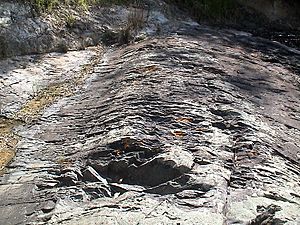Inman River facts for kids
Quick facts for kids Inman |
|
|---|---|

Glaciated pavement in the Inman River
|
|
|
Location of the river mouth in South Australia
|
|
| Native name | Moo-oola; Moogoora |
| Country | Australia |
| State | South Australia |
| Region | Fleurieu Peninsula |
| Physical characteristics | |
| Main source | Mount Lofty Range Bald Hills 137 m (449 ft) 35°30′S 138°25′E / 35.500°S 138.417°E |
| River mouth | Encounter Bay Victor Harbor 0 m (0 ft) 35°33′40″S 138°36′40″E / 35.56111°S 138.61111°E |
| Length | 26 km (16 mi) |
The Inman River is a small river in South Australia, Australia. It flows down the eastern side of the Fleurieu Peninsula. This river is an important natural feature of the region.
Journey of the Inman River

The Inman River starts high up in the Mount Lofty Ranges. Its waters begin in an area called Bald Hills. From there, the river flows through the beautiful Inman Valley.
The river travels about 26 kilometers (16 miles) towards the southeast. It drops about 142 meters (466 feet) from its source to its end. Finally, the Inman River empties into Encounter Bay. This bay is located on the southern side of Victor Harbor.
Why is it called Inman River?
The Inman River got its name from Inspector Henry Inman. He was the first commander of the South Australia Police. In August 1838, he chased two people who were thought to be escaped convicts to this river.
The local Aboriginal people had their own names for the river. They called it Moo-oola and Moogoora. The river's mouth was known as Mugurank, which means 'place of hammerstones'.
Discovering Selwyn Rock
One of the most interesting features of the Inman River is Selwyn Rock. This special rock formation is found in the riverbed near the town of Inman Valley.
Selwyn Rock is a 'glaciated pavement'. This means it's a rock surface that was smoothed and scratched by ancient glaciers. You can clearly see the marks, called glacial striations, left by these huge sheets of ice.
A scientist named Alfred Richard Cecil Selwyn first found this amazing rock in 1859. It helps us understand what the Earth was like long, long ago!


